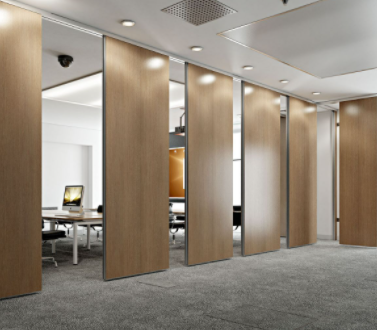Acoustic moving walls have many names – they’re also known as demountable walls or operable walls, among other labels. Whatever you call them, they’re typically either floor-to-ceiling or partial panels that can be moved around to adjust the layout of an interior space.
They’re designed to transform a single large space into multiple small spaces without much effort, and you can move or conceal them when they’re not needed. This flexibility and efficiency makes movable partitions suitable for a variety of spaces and purposes.
If you’d like to learn more about the different types of movable walls and the places they can be used, this blog will tell you everything you need to know about these clever spatial solutions.
Types of movable partitions
According to the Designing Buildings Construction Wiki, the common configurations for movable walls are modular and unitised (assembled from sections, or semi-assembled and faster to install).
They can also either be permanent panels in a fixed shape, or foldable or retractable either horizontally or vertically. These types can be manually operated or electrically operated.
Horizontal room dividers are the most commonly used type, and electrical mechanisms are more expensive than standard manual systems. Regardless of your budget or spatial requirements, there are lots of different models to choose from, including:
- Sliding walls – Either surface-mounted on a floor track or top-hung from the ceiling, sliding walls can move to one side or part to both sides. They can also work as sliding folding partitions if they’re hinged and can fold back on themselves.
- Concertina room dividers – Running along a ball-bearing track, concertina walls are lightweight and fold away neatly at one end of the track when the concertina partition is not in use.
- Acoustic partitions – One of the big issues with demountable partitions is that they don’t do much for noise reduction, which is why specially soundproofed acoustic movable partitions are available for increased privacy.
Any of these operable wall systems could make a massive difference to the way your business or service works, allowing you to make the most of your interior footprint from one day to the next.
Movable wall applications
Movable walls of all kinds are adaptable to the needs of a range of environments, from public to corporate. While their primary purpose is to divide rooms, movable partitions are multi-functional solutions for many business sectors and community spaces, such as:
1) Schools and universities
Splitting classrooms into smaller study spaces or lecture theatres into smaller seminar rooms, or separating assembly halls for exams or PE classes – the possibilities are endless for using movable walls to minimise distractions in education establishments.
2) Offices and conference venues
You can divide open-plan offices with movable partitions to create private meeting rooms or separate break areas from work areas. Large conference facilities can also be split up according to the volume of attendance, or to enable workshops to take place.
3) Healthcare services
Hospitals, GP surgeries, care homes – all of these places can make good use of movable walls for visual and acoustic privacy. They can also help to facilitate social distancing in reception areas and waiting rooms to prevent the spread of airborne diseases.
4) Hotels and hospitality
From hostels and holiday rentals to high-end hotels and resorts, guests will expect comfort and privacy, with minimal disruption from other people in the vicinity. Whether it’s a large dining room, a wedding reception venue, or a corporate gathering, movable partitions can come in handy.
5) Churches and village halls
Places of worship or community centres can also benefit from the versatility of movable walls. Whether cutting down background noise for peaceful contemplation or creating areas for private conversations, they can greatly improve the user experience for these facilities.
6) Sports and entertainment
Sports stadiums and music arenas host a huge number of people, and these crowds need to be channelled in and out efficiently. Similarly, museums and art galleries need to create directional flows for their exhibitions. Movable partitions assist with security while still allowing movement.
7) Retail and restaurants
Shops, banks, eateries – any type of retail establishment can use movable walls to set up designated areas and passages, keeping patrons separate or limiting the flow of customers into certain areas, such as checkouts, cashpoints, self-serve buffets, or anything similar.
8) Residential communities
Community living with shared amenities is becoming more popular, but spaces like fitness centres, pools, and mail or laundry rooms might benefit from movable partitions to enhance the sense of privacy and the quality of the experience for the residents.
9) Industrial operations
In some cases, demountable walls can be made with additional properties, such as increased thermal or corrosion resistance, or extra soundproofing or waterproofing. The partitions can serve as protective barriers in laboratories or factories in many sectors, from pharmaceuticals to food.
10) Social distancing in public buildings
Hospitals aren’t the only places that need to concern themselves with limiting the spread of illness. As we’ve all seen throughout the COVID-19 pandemic, glass or plastic movable partitions can be invaluable in protecting service workers and members of the public against airborne viruses, from shops and public transport to civil offices and schools.
Benefits of movable walls
There are countless benefits of movable wall panels, but here are the top eight advantages:
- Low maintenance – easy to install, operate, and clean
- Flexible arrangements to keep up with changing needs
- Increases privacy and reduces noise pollution
- More cost-effective than constructing actual walls
- Customisable to suit your desired aesthetic
- Durable construction that won’t rot or colour-fade
- Often made with recyclable materials to improve sustainability
- Improves functionality – e.g. supporting collaboration or social distancing
With all these reasons to invest in movable walls, why wouldn’t you want to use these convenient mechanisms? Whether it’s a sliding wall or concertina wall, surface-mounted or top-hung, the perfect movable wall product is waiting for you.
 HammBurg Be informed with latest news, reviews, entertainment, lifestyle tips, and much more.
HammBurg Be informed with latest news, reviews, entertainment, lifestyle tips, and much more.




